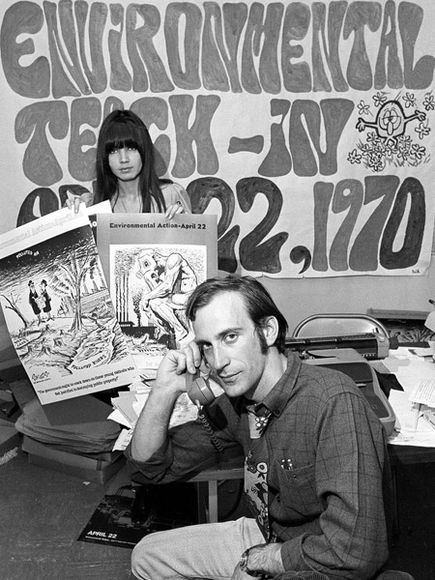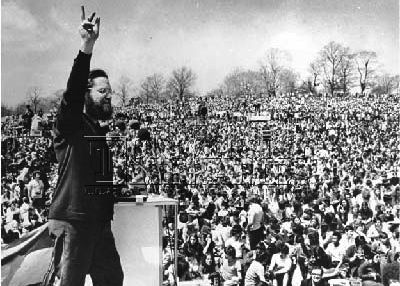
The first Earth Day – April 22, 1970 – is sometimes said to have marked the beginning of the modern environmental movement. It predates the U.S. Environmental Protection Agency, for example. It’s hard to imagine it now, but the first Earth Day was a revelation to many, a way not only of raising consciousness about environmental issues but also of bringing together separate groups that had been fighting separately against issues including oil spills, pollutions from factories and power plants, raw sewage, toxic dumps, pesticides, the loss of wilderness, air pollution and more. At the first Earth Day in 1970, an estimated 20 million Americans – mostly white, mostly young – took to the streets, parks, and auditoriums to demonstrate for a healthy environment and to participate in teach-ins.
Since then, Earth Day has always been celebrated on April 22.
Read a statement about 2019’s Earth Day from Kathleen Rogers, president of the Earth Day Network.
Earth Day 2019 is focused on protecting species. Learn more.
2020 will be the 50th Earth Day: Read about plans

In the late 1960s, there were love-ins, be-ins … and, like the first Earth Day, teach-ins. Here are two organizers of the first Earth Day in 1970. Image via AP/Lincoln&Rose.
Wisconsin Senator Gaylord Nelson is widely credited with suggesting the first Earth Day on April 22. The date was selected in part with college campuses in mind; April 22 fell between spring break and final exams.
The date of the first Earth Day also stemmed from a much earlier observance: Arbor Day, which began in Nebraska in 1872. The most common practice on Arbor Day was the planting of trees. J. Sterling Morton was a Nebraska pioneer, a writer and editor for Nebraska’s first newspaper, and later secretary of the Nebraska Territory. He advocated planting trees in what was then a dusty and treeless prairie. At a meeting of the State Board of Agriculture in January 1872, Morton proposed that Nebraska citizens set aside April 10 as a day to plant trees. He suggested offering prizes as incentives for communities and organizations that planted the most trees. It’s said that Nebraskans planted about one million trees on that first Arbor Day in 1872.
Ten years later, in 1882, Nebraska declared Arbor Day as a legal holiday and the date was changed to Morton’s birthday, April 22. Arbor Day grew to become a national observance.
It seemed natural to schedule April 22, 1970 – Arbor Day – as the first Earth Day. Today, a common practice in celebration of Earth Day is still to plant new trees.

Here is Arbor Day at N.Y. Public School #4, 173rd St. & Fulton Ave., New York. Date unknown. Via Library of Congress.
Kathleen Rogers is a former environmental attorney who has led the Earth Day Network since 2001. She’s a frequent commentator on environmental issues in the media (CNN, Fox News, NPR, Time, Washington Post, Los Angeles Times). She wrote of Earth Day:
Earth Day is now a global event each year, and we believe that more than 1 billion people in 192 countries now take part in what is the largest civic-focused day of action in the world.
It is a day of political action and civic participation. People march, sign petitions, meet with their elected officials, plant trees, clean up their towns and roads. Corporations and governments use it to make pledges and announce sustainability measures. Faith leaders, including Pope Francis, connect Earth Day with protecting God’s greatest creations, humans, biodiversity and the planet that we all live on.
Earth Day Network is asking people to join the 2019 Protect our Species campaign. Goals are to:
– Educate and raise awareness about the accelerating rate of extinction of millions of species and the causes and consequences of this phenomenon.
– Achieve major policy victories that protect broad groups of species as well as individual species and their habitats.
– Build and activate a global movement that embraces nature and its values.
– Encourage individual actions such as adopting a plant based diet and stopping pesticide and herbicide use.
Want to participate? Sign up to join the Earth Day Network
Bottom line: Why do we celebrate Earth Day on April 22? The date stems from an earlier observance, Arbor Day. 2019’s Earth Day is focused on protection of species.
from EarthSky http://bit.ly/2vfmhjp

The first Earth Day – April 22, 1970 – is sometimes said to have marked the beginning of the modern environmental movement. It predates the U.S. Environmental Protection Agency, for example. It’s hard to imagine it now, but the first Earth Day was a revelation to many, a way not only of raising consciousness about environmental issues but also of bringing together separate groups that had been fighting separately against issues including oil spills, pollutions from factories and power plants, raw sewage, toxic dumps, pesticides, the loss of wilderness, air pollution and more. At the first Earth Day in 1970, an estimated 20 million Americans – mostly white, mostly young – took to the streets, parks, and auditoriums to demonstrate for a healthy environment and to participate in teach-ins.
Since then, Earth Day has always been celebrated on April 22.
Read a statement about 2019’s Earth Day from Kathleen Rogers, president of the Earth Day Network.
Earth Day 2019 is focused on protecting species. Learn more.
2020 will be the 50th Earth Day: Read about plans

In the late 1960s, there were love-ins, be-ins … and, like the first Earth Day, teach-ins. Here are two organizers of the first Earth Day in 1970. Image via AP/Lincoln&Rose.
Wisconsin Senator Gaylord Nelson is widely credited with suggesting the first Earth Day on April 22. The date was selected in part with college campuses in mind; April 22 fell between spring break and final exams.
The date of the first Earth Day also stemmed from a much earlier observance: Arbor Day, which began in Nebraska in 1872. The most common practice on Arbor Day was the planting of trees. J. Sterling Morton was a Nebraska pioneer, a writer and editor for Nebraska’s first newspaper, and later secretary of the Nebraska Territory. He advocated planting trees in what was then a dusty and treeless prairie. At a meeting of the State Board of Agriculture in January 1872, Morton proposed that Nebraska citizens set aside April 10 as a day to plant trees. He suggested offering prizes as incentives for communities and organizations that planted the most trees. It’s said that Nebraskans planted about one million trees on that first Arbor Day in 1872.
Ten years later, in 1882, Nebraska declared Arbor Day as a legal holiday and the date was changed to Morton’s birthday, April 22. Arbor Day grew to become a national observance.
It seemed natural to schedule April 22, 1970 – Arbor Day – as the first Earth Day. Today, a common practice in celebration of Earth Day is still to plant new trees.

Here is Arbor Day at N.Y. Public School #4, 173rd St. & Fulton Ave., New York. Date unknown. Via Library of Congress.
Kathleen Rogers is a former environmental attorney who has led the Earth Day Network since 2001. She’s a frequent commentator on environmental issues in the media (CNN, Fox News, NPR, Time, Washington Post, Los Angeles Times). She wrote of Earth Day:
Earth Day is now a global event each year, and we believe that more than 1 billion people in 192 countries now take part in what is the largest civic-focused day of action in the world.
It is a day of political action and civic participation. People march, sign petitions, meet with their elected officials, plant trees, clean up their towns and roads. Corporations and governments use it to make pledges and announce sustainability measures. Faith leaders, including Pope Francis, connect Earth Day with protecting God’s greatest creations, humans, biodiversity and the planet that we all live on.
Earth Day Network is asking people to join the 2019 Protect our Species campaign. Goals are to:
– Educate and raise awareness about the accelerating rate of extinction of millions of species and the causes and consequences of this phenomenon.
– Achieve major policy victories that protect broad groups of species as well as individual species and their habitats.
– Build and activate a global movement that embraces nature and its values.
– Encourage individual actions such as adopting a plant based diet and stopping pesticide and herbicide use.
Want to participate? Sign up to join the Earth Day Network
Bottom line: Why do we celebrate Earth Day on April 22? The date stems from an earlier observance, Arbor Day. 2019’s Earth Day is focused on protection of species.
from EarthSky http://bit.ly/2vfmhjp


Aucun commentaire:
Enregistrer un commentaire